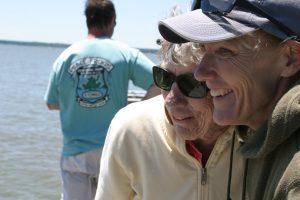 Written by Karen Kovacs, PT, OCS, USAT Level 1 Coach
Written by Karen Kovacs, PT, OCS, USAT Level 1 Coach
Sighting. The shortest distance between two points is a straight line.
No time like now to get used to sighting for your destination while swimming in open water. Keep in mind, you will have to factor in the current, tide, wind and waves as you select landmarks to help keep you on track.
While you are doing your pool swims, start trying to figure out how often you actually need to peek or lift your head out of the water to be sure you are maintaining a straight line. You want that motion as smooth as possible, so that involves a quick look and lifting of your head either as you are exhaling or after you take a breath. This can be exhausting and put an unexpected stress on your neck if you wait until the day of the event to try this when you are forced to sight.
Some people definitely swim in a straighter line than others, and the last thing you want to do is waste a lot of time and energy either swimming off course or in a crooked line or sighting too frequently. That is why it is important to practice this skill in the pool. Ideally, you can do this outside the swim lane lines which forces you back on course every time you bump one. You can get a feel for whether or not you tend to drift to the left or right, too.
Be sure to do this in the open water, too. Find a distant landmark, and determine the ideal number of strokes to go before you lift your head to sight. Though there will be safety kayakers close by during the event you’ve registered for, you don’t want to rely on someone yelling to keep you on course. And you certainly don’t want to bump into them.
If you wear glasses, you can purchase goggles for about $20 that have magnifying lenses (like the “cheaters” many of us over the age of forty are now forced to use for reading). These helped take away a tremendous amount of anxiety for my husband who used to not be able to see the bright yellow buoys during a triathlon, let alone spot a landmark miles away.
Sighting to swim in a straight line in the open water is definitely a skill that takes practice. With so many variables that cannot be controlled in the open water, this is one component of open water swimming you will want to try to master.
Vid ere est credere. Seeing is believing.
Karen Kovacs, PT, OCS is a physical therapist and clinical director of Tidewater Physical Therapy‘s Gloucester Point location. She is an accomplished endurance athlete and is a USAT Level 1 Coach.

